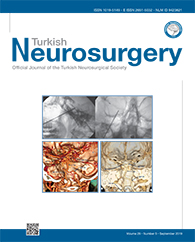2Namik Kemal University, School of Medicine, Department of Neurosurgery, Tekirdag, Turkey
3Namik Kemal University, Faculty of Arts and Sciences, Department of Molecular Biology and Genetics, Tekirdag, Turkey
4Istanbul Medipol University, School of Medicine, Department of Medical Pharmacology, Istanbul, Turkey
5Istanbul Rumeli University, Corlu Reyap Hospital, Department of Neurosurgery, Tekirdag, Turkey DOI : 10.5137/1019-5149.JTN.26339-19.2 AIM: To investigate the effects of methylphenidate (MPH), on intervertebral disc tissue (IVD) cell cultures and extracellular matrix structures. Changes in the expression of some important marker genes involved in anabolic and catabolic mechanisms of IVD extracellular matrix formation were also evaluated.
MATERIAL and METHODS: Primary cultures of nucleus pulposus cells (NPCs) and annulus fibrosus cells (AFCs) were isolated from tissues obtained from the operated patients. Cell viability and proliferation were tested, and the cell surface morphologies were evaluated by microscopy. The expressions of the chondroadherin (CHAD), cartilage oligomeric matrix protein (COMP), interleukin-1 beta (IL-1β) and matrix metalloproteinase (MMP) -7 and MMP-19 genes were evaluated using the quantitative real-time polymerase chain reaction (qRT-PCR). A value of p<0.05 was considered statistically significant.
RESULTS: The viability and proliferation of intervertebral disc tissue cells decreased in response to MPH treatment and the expression of the investigated genes also changed.
CONCLUSION: The data obtained from in-vitro studies may not directly adaptable to clinical applications. However, the fact that the central nervous system stimulant MPH can suppress proliferation of cells derived from IVD tissue should be considered carefully by clinicians.
Keywords : Cartilage oligomeric matrix protein, Chondroadherin, Interleukin-1 beta, Intervertebral disc, Matrix metalloproteinase, Methylphenidate




